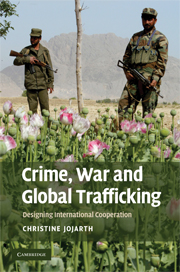Book contents
- Frontmatter
- Contents
- List of figures
- List of tables
- List of abbreviations
- Preface and acknowledgments
- 1 Introduction
- 2 The concept of legalization
- 3 Problem constellation
- 4 Narcotic drugs: UN Convention against Illicit Traffic in Narcotic Drugs and Psychotropic Substances
- 5 Money laundering: the Financial Action Task Force and its Forty Recommendations
- 6 Conflict diamonds: the Kimberley Process Certification Scheme
- 7 Small arms and light weapons: the United Nations Program of Action
- 8 Conclusion
- References
- Index
Preface and acknowledgments
Published online by Cambridge University Press: 02 July 2009
- Frontmatter
- Contents
- List of figures
- List of tables
- List of abbreviations
- Preface and acknowledgments
- 1 Introduction
- 2 The concept of legalization
- 3 Problem constellation
- 4 Narcotic drugs: UN Convention against Illicit Traffic in Narcotic Drugs and Psychotropic Substances
- 5 Money laundering: the Financial Action Task Force and its Forty Recommendations
- 6 Conflict diamonds: the Kimberley Process Certification Scheme
- 7 Small arms and light weapons: the United Nations Program of Action
- 8 Conclusion
- References
- Index
Summary
“But isn't this way too dangerous?” my mother-in-law asked whenever my research topic came up in our conversations. “I don't want you to get killed by these gangsters.” Each time I tried to reassure her: “No, it is really not going to be that sort of crime-and-murder book you imagine.” No blonde wigs, no sunglasses, no bulletproof vests. The way I set out to explore the shady world stretched between crime and war was not through undercover meetings with Viktor Bout, the legendary “Merchant of Death,” or with his client, Manuel Marulanda, the world's oldest guerrilla leader and drug king. Instead, I spent the past five years interviewing policymakers and diplomats of all ranks and nationalities, industry representatives, and NGO leaders. I plowed through every imaginable written source on the subject. This was admittedly non-glamorous and required perseverance and analytic acuity rather than bravado and guile. The result of this endeavor may not be an adrenaline-packed thriller. But I hope to show that the big picture on how drugs, dirty money, diamonds, and arms circulate in the multi-billion dollar illicit global economy and how policymakers have tried to fight these different types of trafficking can be as fascinating as a series of anecdotes from the underworld.
On a more theoretical level, I want to explore how international cooperation on global trafficking can be facilitated through well-designed institutions.
- Type
- Chapter
- Information
- Crime, War, and Global TraffickingDesigning International Cooperation, pp. xiii - xviPublisher: Cambridge University PressPrint publication year: 2009



